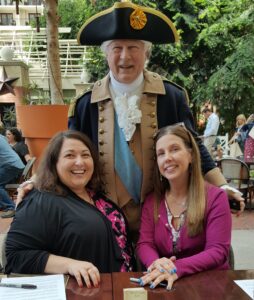We are delighted to welcome our guest, bestselling author Stephanie Dray, to the blog this month.
Washington in the Round: Exploring a Legend Through Fiction
by Stephanie Dray

Vern with Stephanie Dray (left) and co-author Laura Kamoie at the 2019 Historical Novel Society Conference in Maryland.
In the rich tapestry of American history, the persona of George Washington looms as a colossal figure. He’s on Mount Rushmore, the nation’s capital bears his name and is ornamented by a giant monument. But as with all the iconic figures of American history, the perception of this leader varies dramatically depending upon the lens through which he is viewed.
In times of continued racial tension, it is right to remember that he was a slaveholder. In times when presidential candidates talk about how we ought to have a president for life, it is right to remember that George Washington relinquished his power, refused to be king, and set in motion the democratic principles that have served our nation for more than two centuries.
But Washington doesn’t just look different depending on the angle from which we’re viewing him. He also looks different from the vantage point of his contemporaries.
In my novel, “America’s First Daughter” co-authored with Laura Kamoie, the American Revolution and the early years of the country are seen through the eyes of Martha “Patsy” Jefferson Randolph. For Patsy, her initial understanding of the American Revolution is deeply intertwined with the actions and beliefs of her father, Thomas Jefferson. George Washington, in this narrative, is a secondary figure, much overshadowed by the more direct influence of her father, especially his role in crafting the Declaration of Independence.
As Patsy matures, of course her perspective shifts. In the early years of the new nation, she more likely observed Washington not as a detached historical figure but through the lens of her father’s political struggles, particularly with Alexander Hamilton. Washington, from the point-of-view of the Jeffersons, emerges not as the unassailable hero of popular imagination but as a leader entangled in the complex web of early American politics, seemingly unable to rein in Hamilton’s influence.
In “My Dear Hamilton”, a different view of George Washington emerges, as seen through the eyes of Eliza Hamilton. For Eliza, Washington is a figure of deep reverence and admiration. The Hamiltons, and Eliza in particular, idolized him not only for his exemplary leadership but also for his integrity as a role model.
It is his character as a gentleman that deeply resonates with Eliza as he balances the heavy weight of the war upon his shoulders. He exudes a sense of honor, dignity, and a profound sense of duty. Their interactions are marked by Washington’s respectful and measured demeanor, a stark contrast to her much more intemperate husband, Alexander Hamilton.
However, a notable moment of tension arises when Washington refuses to grant Hamilton a military command, leading to a dramatic rift. Despite this, Eliza remains eager for reconciliation, her esteem for Washington undiminished. She sees him not only as the epitome of the American hero but also as a leader who embodies the values and aspirations of the new nation.
This multifaceted portrayal highlights Washington’s influence not only through his public deeds but also through his personal virtues. And Eliza perpetuated the legend of George Washington through her work on his national monument. As the musical says, she told his story. And she told it because she knew him personally.
The entwining of the personal and the political in forming an opinion about George Washington was even more evident when I was writing “The Women of Chateau Lafayette.” Through the eyes of the Lafayette family, particularly Gilbert du Motier, Marquis de Lafayette, and his wife Adrienne, Washington is a father figure–a mentor who provided guidance and inspiration during the Revolutionary Era. The couple even named their first son after him. This familial sentiment deeply influences how the Lafayettes live their lives, not to mention how they perceive Washington, framing him as a person of great significance beyond his public persona.
However, when Lafayette is imprisoned during the French Revolution, Adrienne’s frustration with Washington’s seemingly indifferent response to their plight seems justified. While historically, Washington was navigating a delicate balance of American interests, his lack of support for the Lafayettes during their time of need paints a picture of an emotionally cold leader caught in the throes of geopolitical pragmatism.
Which of these versions of Washington is the correct one? Perhaps all of them. But I look forward to seeing Washington through yet another set of eyes in our forthcoming novel “A Founding Mother” about Abigail Adams and her daughter Nabby.
BIO
STEPHANIE DRAY is a New York Times, Wall Street Journal & USA Today bestselling author of historical fiction. Her award-winning work has been translated into ten languages and tops lists for the most anticipated reads of the year. She lives in Maryland with her husband, cats, and history books.
While most of my George Washington research falls in the non-fiction area, I do enjoy the fictionalized stories of our founding era. My wife and I have read all of Stephanie Dray’s novels of the period, and look forward to reading more. Vern

